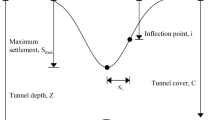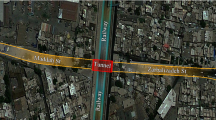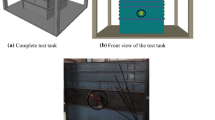Abstract
Surface settlements of soil due to tunneling are caused by stress relief and subsidence due to movement of support by excavation. There are significant discrepancies between empirical solutions to predict surface settlement trough because of different interpretations and database collection by different authors. In this paper, the shape of settlement trough caused by tunneling in cohesive ground is investigated by different approaches, namely analytical solutions, empirical solutions, and numerical solutions by the finite element method. The width of settlement trough was obtained by the finite element method through establishing the change in the slope of the computed settlement profile. The finite element elastic-plastic analysis gives better predictions than the linear elastic model with satisfactory estimate for the displacement magnitude and slightly overestimated width of the surface settlement trough. The finite element method overpredicted the settlement trough width i compared with the results of Peck for soft and stiff clay, but there is an excellent agreement with Rankin’s estimation. The results show that there is a good agreement between the complex variable analysis for Z/D = 1.5, while using Z/D = 2 and 3, the curve diverges in the region faraway from the center of the tunnel.



















Similar content being viewed by others
References
Addenbrooke T, Potts D, Puzrin A (1997) The influence of pre-failure soil stiffness on the numerical analysis of tunnel construction. Geotechnique 47(3):693–712
Atkinson JH, Potts DM (1977) Stability of a shallow circular tunnel in cohesionless soil. Geotechnique 27(2):203–213
Attewell PB, Farmer IW (1974) Ground deformation resulting from shield tunneling in London clay. Can Geotech J Can 11(3):380–395
Augard CE (1997) Numerical modeling of tunneling processes for assessment of damage to building. Ph.D. thesis, University of Oxford
Britto AM, Gunn MJ (1987) Critical state soil mechanics via finite elements. Wiley, New York
Broms BB, Bennermark H (1967) Stability of clay at vertical openings. J Soil Mech Found Div ASCE 93(SM1):71–95
Chow L (1994) Prediction of surface settlement due to tunneling in soft ground. MSc. thesis, University of Oxford
Clough GW, Schmidt B (1981) Excavation and tunneling. In: Brand EW, Brenner RP (eds) Soft clay engineering, Chap 8. Elsevier
Cording EJ, Hansmire WH (1975) Displacement around soft ground tunnels. General Report: Session IV, Tunnels in Soil. In: Proceedings of 5th Panamerican congress, on soil mechanics and foundation engineering
Franzius JN, Potts DM, Burland JB (2005) The influence of soil anisotropy and K0 on ground surface movements resulting from tunnel excavation. Geotechnique 55(3):189–199
Fujita K (1982) Prediction of surface settlements caused by shield tunneling. In: Proceedings of the international conference on soil mechanics, vol 1. Mexico City, Mexico, pp. 239–246
Gunn M (1993) The prediction of surface settlement profiles due to tunneling. In: Predictive soil mechanics, proceedings of worth memory symposium. Thomas Telford, London, pp 304–316
Mair R, Gunn M, O’Reilly M (1981) Ground movements around shallow tunnels in soft clay. In: Proceedings of 10th international conference on soil mechanics and foundation engineering, vol 2, Stockholm, pp 323–328
Masin D (2009) 3D modeling of an NATM tunnel in high K0 clay using two different constitutive models. J Geotech Geoenviron Eng ASCE 135(9):1326–1335
Muskhclishvili NI (1953) Some basic problem of the mathematical theory of elasticity (Translated from Russian by Radok Noordhoff JRM) Groniyer
Norgrove WB, Cooper I, Attewell PB (1979) Site investigation procedures adopted for the northumbrian water authority’s tyne side sewerage scheme, with special reference to settlement prediction when tunneling through urban areas. In: Proceedings of Tunneling, vol 79, London, pp 79–104
O’Reilly MP, New BM (1982) Settlements above tunnels in the UK-their magnitude and prediction. Tunneling 82:173–181
Oteo CS, Sagaseta C (1982) Prediction of settlements due to underground openings. In: Proceedings of international symposium numerical method in geomechanics Zurich, Balema, pp 653–659
Peck RB (1969) Deep excavations and tunneling in soft ground. In: Proceedings of the 7th international conference on soil mechanics and foundation engineering, state of the art volume, Mexico pp 225–290
Poulos HG, Davis EH (1974) Elastic solutions for soil and rock mechanics. Wiley, New York
Rankin W (1988) Ground movements resulting from urban tunneling. In: Prediction and effects, proceedings of 23rd conference of the engineering group of the geological society, London Geological Society, pp 79–92
Sagaseta C (1987) Analysis of undrained soil deformation due to ground loss. Geotechnique 37(3):301–320
Tan WL, Ranjith PG (2003) Numerical analysis of pipe roof reinforcement in soft ground tunneling. In: Proceedings of the 16th international conference on engineering mechanics
Verruijt A (1997) A complex variable solution for deforming circular tunnels in an elastic half-plane. Int J Numer Anal Methods Geomech 21:77–89
Verruijt A, Booker JR (1996) Surface settlements due to deformation of a tunnel in an elastic half- plane. Geotechnique 46(4):753–756 (London, England)
Verruijt A, Booker JR (2000) Complex variable solution of Mindlin’s problem of an excavated tunnel. In: Developments in theoretical geomechanics. A.A. Balkema, Rotterdam, pp 3–22
Author information
Authors and Affiliations
Corresponding author
Appendix
Appendix
1.1 Mindlin’s problem
In the ξ-plane, the function F is to be considered along the boundary \( \xi = \alpha \sigma = \alpha \exp (i\theta ) \)
where the integration path should be such that the material (inside the cavity) lies to the left when traveling along the integration path. This means that ds = −rdβ. Because on the boundary of the cavity z = −h−r cos β, it follows that the boundary function F for this part of the solution, which will be denoted by F 1, is:
Elaboration of the integrals gives
The expression (17) gives the integrated surface traction F 1 as a function of β, the angular coordinate along the circular boundary in the z plane. This quantity is needed, however, as a function of θ, the angle along the inner circular boundary in the ξ-plane, for that reason the relation between these two angles:
where α is the geometric parameter r/h, and the ratio of the radius of the circular cavity to its depth is as follows:
Along the inner circular boundary in ξ-plane ξ = ασ = α.exp (iθ), with equation (18) this gives, after some mathematical manipulations:
These equations represent a circle of radius r around a point at a depth h, because:
The angle β can be expressed as:
The value of β is defined such that it varies continuously from β = 0 to β = 2π in the interval from θ = 0 to θ = 2π. This can be accomplished by modifying the standard function l = arc tan (z/x) in such a way that for values of x and z in four quadrants, the value of the function varies continuously from 0 to 2π when θ = 0 to θ = 2π.
The function F 1 can be calculated from the formula (17), which can be written as:
Rights and permissions
About this article
Cite this article
Fattah, M.Y., Shlash, K.T. & Salim, N.M. Prediction of settlement trough induced by tunneling in cohesive ground. Acta Geotech. 8, 167–179 (2013). https://doi.org/10.1007/s11440-012-0169-4
Received:
Accepted:
Published:
Issue Date:
DOI: https://doi.org/10.1007/s11440-012-0169-4




